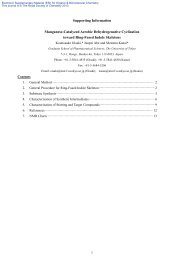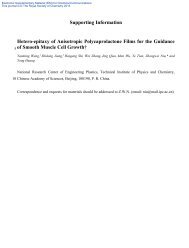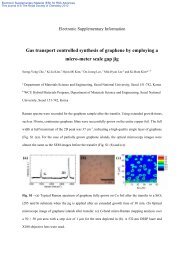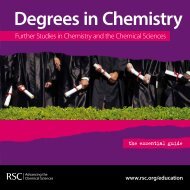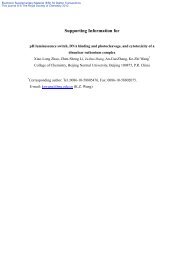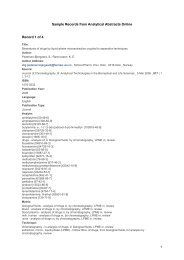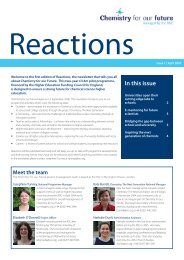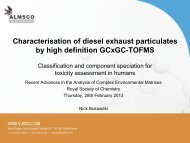Supporting Information-Botta - Royal Society of Chemistry
Supporting Information-Botta - Royal Society of Chemistry
Supporting Information-Botta - Royal Society of Chemistry
You also want an ePaper? Increase the reach of your titles
YUMPU automatically turns print PDFs into web optimized ePapers that Google loves.
Electronic Supplementary Material (ESI) for Physical <strong>Chemistry</strong> Chemical Physics<br />
This journal is © The Owner Societies 2011<br />
<strong>Supporting</strong> <strong>Information</strong> for:<br />
Efficient Crystallization Induced Emissive Materials<br />
Based on a Simple Push-Pull Molecular Structure<br />
Elena Cariati,* ,a Valentina Lanzeni, a Elisa Tordin, a Renato Ugo, a Chiara <strong>Botta</strong>,* ,b Alberto Giacometti<br />
Schieroni, b Angelo Sironi c and Dario Pasini d<br />
a Dipartimento CIMA “Lamberto Malatesta”, University <strong>of</strong> Milano,UdR INSTM di Milano, via<br />
Venezian 21, 20133 Milano, Italy.<br />
b<br />
Istituto per lo Studio delle Macromolecole (ISMAC), CNR, Via Bassini 15, 20133 Milano, Italy.<br />
c Dipartimento CSSI, University <strong>of</strong> Milano, via Venezian 21, 20133 Milano, Italy.<br />
d Dipartimento di Chimica Organica, University <strong>of</strong> Pavia, Viale Taramelli 10, Pavia, Italy.<br />
1
Electronic Supplementary Material (ESI) for Physical <strong>Chemistry</strong> Chemical Physics<br />
This journal is © The Owner Societies 2011<br />
Figure S1. 1 H NMR spectrum <strong>of</strong> compound 3.<br />
Figure S2 13 C NMR spectrum <strong>of</strong> compound 3.<br />
2
Electronic Supplementary Material (ESI) for Physical <strong>Chemistry</strong> Chemical Physics<br />
This journal is © The Owner Societies 2011<br />
PL Intensity (arb.units)<br />
1<br />
1<br />
2<br />
3<br />
4<br />
5<br />
6<br />
7<br />
0<br />
450 500 550 600 650 700<br />
Wavelength (nm)<br />
Figure S3. PL spectra <strong>of</strong> 3 in CH 3 OH/water mixtures with increasing water content from 1 to 7.<br />
1<br />
amorphous<br />
crystalline<br />
PL Intensity (arb. units)<br />
0<br />
440 480 520 560 600<br />
Wavelength (nm)<br />
Figure S4. PL spectra <strong>of</strong> 3 film in the crystalline and amorphous phases excited at 350nm, the spectra<br />
are normalized to the crystalline film emission<br />
3
Electronic Supplementary Material (ESI) for Physical <strong>Chemistry</strong> Chemical Physics<br />
This journal is © The Owner Societies 2011<br />
Figure S5 . XRPD patterns, diagonally shifted in order to highlight their relative intensities, <strong>of</strong> the spin<br />
casted films <strong>of</strong> 1: black pattern, as casted; red pattern, upon heating and quenching; blue pattern after<br />
two weeks. Note that the film are preferentially oriented (the two strongest peaks being the 100 and<br />
300, respectively).<br />
Single crystal data collection, structure solution and refinement.<br />
Crystal samples were mounted on glass fibres in air and collected at RT on a Bruker AXS APEX2<br />
CCD area-detector diffractometer. Graphite-monochromatized Mo-Kα (λ = 0.71073 Å) radiation was<br />
used with the generator working at 50 kV and 35 mA. Orientation matrixes were initially obtained from<br />
least-squares refinement on ca. 300 reflections measured in three different ω regions, in the range 0 < θ<br />
< 23°; cell parameters were optimised on the position, determined after integration, <strong>of</strong> the most<br />
accurate reflections. The intensity data were collected in the full sphere (ω scan method); the first 60<br />
frames were recollected to have a monitoring <strong>of</strong> crystal decay, which was not observed; an empirical<br />
absorption correction was applied (SADABS 1 ). The structures were solved by direct methods (SIR97) 2<br />
and refined with full-matrix least squares (SHELX97) 3 on F 2 on the basis <strong>of</strong> the pertinent independent<br />
reflection; anisotropic temperature factors were assigned to all non-hydrogenic atoms. Hydrogens were<br />
riding on their carbon atoms.<br />
4
Electronic Supplementary Material (ESI) for Physical <strong>Chemistry</strong> Chemical Physics<br />
This journal is © The Owner Societies 2011<br />
Crystal data for 1: C14 H17 N O4, Mr = 263.29, monoclinic, space group P2 1 /c (No. 14), a =<br />
13.179(3), b = 7.241(2), c = 15.270(4) Å, ß = 101.58(1)°, V = 1427.5(6) Å 3 , Z = 4, d calc = 1.225 g cm -3 ,<br />
T = 293(2) K, crystal size = 0.19 × 0.04 × 0.04 mm 3 , µ = 0.09, MoKα radiation λ= 0.71073 Å.<br />
Nominal sample to detector distance 6 cm., 1500 frames (50 s per frame; ∆ω = 0.5°); Refinement <strong>of</strong><br />
176 parameters on 2739 independent reflections out <strong>of</strong> 14246 measured reflections (Rint = 0.0560, Rσ<br />
= 0.0351, 2θ max = 56.0°) led to R1 = 0.0547 (I > 2s(I) , 2138 reflections), wR2 = 0.1743 (all data),<br />
and S = 1.043, with the largest peak and hole <strong>of</strong> 0.22 and -0.25 e Å -3 .<br />
Crystal data for 2: C14 H17 N O4, Mr = 263.29, monoclinic, space group P2 1 /c (No. 14), a =<br />
14.737(1), b = 7.533(1), c = 15.936(1) Å, ß = 115.27(1)°, V = 1599.9(2) Å 3 , Z = 4, d calc = 1.21 g cm -3 ,<br />
T = 293(2) K, crystal size = 0.22 × 0.15 × 0.10 mm 3 , µ = 0.09, MoKα radiation λ= 0.71073 Å.<br />
Nominal sample to detector distance 5 cm., 1500 frames (40 s per frame; ∆ω = 0.5°); Refinement <strong>of</strong><br />
214 parameters on 5125 independent reflections out <strong>of</strong> 14928 measured reflections (Rint = 0.0221, Rσ<br />
= 0.0173, 2θ max = 62.5°) led to R1 = 0.0632 (I > 2s(I), 3232 reflections), wR2 = 0.0959 (all data), and<br />
S = 1.035, with the largest peak and hole <strong>of</strong> 0.50 and -0.27 e Å -3 .<br />
Crystal data for 3: C14 H17 N O4, Mr = 263.29, monoclinic, space group C2/c (No. 15), a = 23.263(3),<br />
b = 7.821(1), c = 19.649(2) Å, ß = 116.61(1)°, V = 3196.2(7) Å 3 , Z = 8, d calc = 1.21 g cm -3 , T = 293(2)<br />
K, crystal size = 0.22 × 0.15 × 0.10 mm 3 , µ = 0.09, MoKα radiation λ= 0.71073 Å.<br />
Nominal sample to detector distance 5 cm., 1500 frames (90 s per frame; ∆ω = 0.5°); Refinement <strong>of</strong><br />
194 parameters on 4111 independent reflections out <strong>of</strong> 22714 measured reflections (Rint = 0.0371, Rσ<br />
= 0.0280, 2θ max = 57.2°) led to R1 = 0.0464 (I > 2s(I), 2449 reflections), wR2 = 0.0888 (all data), and<br />
S = 1.016, with the largest peak and hole <strong>of</strong> 0.15 and -0.15 e Å -3 .<br />
Definitions <strong>of</strong> reported R-indices and weights:<br />
R int = Σ|F o 2 -F o 2 (mean)|/ΣF o 2 ; R σ = Σσ(F o 2 )/ΣF o<br />
2<br />
R1=Σ||F o |-|F c ||/Σ|F o | wR2={Σ[w(F o 2 -F c 2 ) 2 ]/Σ[w(F o 2 ) 2 ]} ½<br />
Goodness <strong>of</strong> fit GoF={S/(n-p)} ½ ={Σ[w(F o 2 -F c 2 ) 2 ]/(n-p)} ½ where n and p are the number <strong>of</strong><br />
observations and refined parameters, respectively.<br />
w=1/[σ 2 (F o 2 ) + (aP) 2 + bP] where P=[2F c 2 + Max(F o 2 ,0)]/3<br />
5
Electronic Supplementary Material (ESI) for Physical <strong>Chemistry</strong> Chemical Physics<br />
This journal is © The Owner Societies 2011<br />
Figure S6. ORTEP view <strong>of</strong> 1-3 (the ellipsoid have been at the 50% probability level)<br />
1<br />
2<br />
3<br />
Sheldrick, G. M. (1996) SADABS, University <strong>of</strong> Göttingen, Germany, to be published.<br />
A. Altomare, M. C. Burla, M. Camalli, G. L. Cascarano, C. Giacovazzo, A. Guagliardi, A. G. G.<br />
Moliterni, G. Polidori, R. Spagna, J. Appl. Cryst. 1999, 32, 115.<br />
G. M. Sheldrick, SHELX-97 Programs for Crystal Structure Analysis (Release 97-2), University<br />
<strong>of</strong> Göttingen (Germany), 1997.<br />
6




